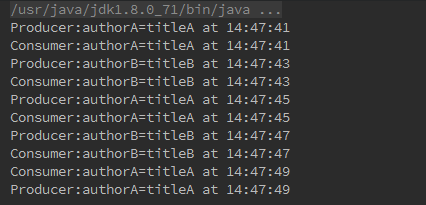Java併發程式設計系列之十七 Condition介面
阿新 • • 發佈:2018-12-21
通過前面的文章,我們知道任何一個Java物件,都擁有一組監視器方法,主要包括wait()、notify()、notifyAll()方法,這些方法與synchronized關鍵字配合使用可以實現等待/通知機制。而且前面我們已經使用這種方式實現了生產者-消費者模式。類似地,Condition介面也提供類似的Object的監視器的方法,主要包括await()、signal()、signalAll()方法,這些方法與Lock鎖配合使用也可以實現等待/通知機制。
相比Object實現的監視器方法,Condition介面的監視器方法具有一些Object所沒有的特性:
- Condition介面可以支援多個等待佇列,在前面已經提到一個Lock例項可以繫結多個Condition,所以自然可以支援多個等待隊列了
- Condition介面支援響應中斷,前面已經提到過
- Condition介面支援當前執行緒釋放鎖並進入等待狀態到將來的某個時間,也就是支援定時功能
使用Condition介面配合Lock鎖的使用例項如下:
Lock lock = new ReentrantLock(); Condition condition = lock.newCondition(); public void conditionWait() throws InterruptedException { lock.lock(); try { //.... condition.await - 1
- 2
- 3
- 4
- 5
- 6
- 7
- 8
- 9
- 10
- 11
- 12
- 13
- 14
- 15
- 16
- 17
- 18
- 19
- 20
- 21
- 22
一般而言,都會將Condition變數作為成員變數。當呼叫await方法後,當前執行緒會釋放鎖並進入Condition變數的等待佇列,而其他執行緒呼叫signal方法後,通知正在Condition變數等待佇列的執行緒從await方法返回,並且在返回前已經獲得了鎖
現在我們已經知道了如何配合Condition和Lock鎖實現等待/通知機制,那麼我們使用這種方式實現生產者-消費者模式:
package com.rhwayfun.concurrency.r0405;import java.text.DateFormat;import java.text.SimpleDateFormat;import java.util.Date;import java.util.concurrent.TimeUnit;import java.util.concurrent.locks.Condition;import java.util.concurrent.locks.Lock;import java.util.concurrent.locks.ReentrantLock;/** * Created by rhwayfun on 16-4-5. */public class ConditionProducerConsumerDemo { //日期格式器 private static DateFormat format = new SimpleDateFormat("HH:mm:ss"); static class Info{ //作者 private String author; //標題 private String title; //是否開始生產的標誌 private boolean produce = true; //Lock鎖 private Lock lock = new ReentrantLock(); //Condition變數 private Condition condition = lock.newCondition(); public Info(){} public Info(String author, String title) { this.author = author; this.title = title; } public String getAuthor() { return author; } public void setAuthor(String author) { this.author = author; } public String getTitle() { return title; } public void setTitle(String title) { this.title = title; } /** * 生產者執行的生產方法 * @param author * @param title * @throws InterruptedException */ public void set(String author,String title) throws InterruptedException { lock.lock(); try { //沒有開始生產就等待 while (!produce){ condition.await(); } //如果已經開始生產 this.setAuthor(author); TimeUnit.SECONDS.sleep(1); this.setTitle(title); //表示已經停止了生產可以取資料了 produce = false; //通知消費者 condition.signal(); }finally { lock.unlock(); } } /** * 消費者執行的消費方法 * @throws InterruptedException */ public void get() throws InterruptedException { lock.lockInterruptibly(); try { //如果已經開始生產就等待 while (produce){ condition.await(); } //如果沒有在生產就就可以取資料 System.out.println(Thread.currentThread().getName() + ":" + this.getAuthor() + "=" + this.getTitle() + " at " + format.format(new Date())); //表示我已經取了資料,生產者可以繼續生產 produce = true; //通知生產者 condition.signal(); }finally { lock.unlock(); } } } static class Producer implements Runnable{ private Info info; public Producer(Info info) { this.info = info; } public void run() { boolean flag = true; for (int i = 0; i < 5; i++){ if (flag){ try { info.set("authorA","titleA"); System.out.println(Thread.currentThread().getName() + ":" + info.getAuthor() + "=" + info.getTitle() + " at " + format.format(new Date())); TimeUnit.SECONDS.sleep(1); } catch (InterruptedException e) { e.printStackTrace(); } flag = false; }else { try { info.set("authorB","titleB"); System.out.println(Thread.currentThread().getName() + ":" + info.getAuthor() + "=" + info.getTitle() + " at " + format.format(new Date())); TimeUnit.SECONDS.sleep(1); } catch (InterruptedException e) { e.printStackTrace(); } flag = true; } } } } static class Consumer implements Runnable{ private Info info; public Consumer(Info info) { this.info = info; } public void run() { for (int i = 0; i < 5; i++){ try { info.get(); TimeUnit.SECONDS.sleep(1); } catch (InterruptedException e) { e.printStackTrace(); } } } } public static void main(String[] args) throws InterruptedException { Info info = new Info(); Thread producer = new Thread(new Producer(info),"Producer"); Thread consumer = new Thread(new Consumer(info),"Consumer"); producer.start(); TimeUnit.SECONDS.sleep(1); consumer.start(); }}- 1
- 2
- 3
- 4
- 5
- 6
- 7
- 8
- 9
- 10
- 11
- 12
- 13
- 14
- 15
- 16
- 17
- 18
- 19
- 20
- 21
- 22
- 23
- 24
- 25
- 26
- 27
- 28
- 29
- 30
- 31
- 32
- 33
- 34
- 35
- 36
- 37
- 38
- 39
- 40
- 41
- 42
- 43
- 44
- 45
- 46
- 47
- 48
- 49
- 50
- 51
- 52
- 53
- 54
- 55
- 56
- 57
- 58
- 59
- 60
- 61
- 62
- 63
- 64
- 65
- 66
- 67
- 68
- 69
- 70
- 71
- 72
- 73
- 74
- 75
- 76
- 77
- 78
- 79
- 80
- 81
- 82
- 83
- 84
- 85
- 86
- 87
- 88
- 89
- 90
- 91
- 92
- 93
- 94
- 95
- 96
- 97
- 98
- 99
- 100
- 101
- 102
- 103
- 104
- 105
- 106
- 107
- 108
- 109
- 110
- 111
- 112
- 113
- 114
- 115
- 116
- 117
- 118
- 119
- 120
- 121
- 122
- 123
- 124
- 125
- 126
- 127
- 128
- 129
- 130
- 131
- 132
- 133
- 134
- 135
- 136
- 137
- 138
- 139
- 140
- 141
- 142
- 143
- 144
- 145
- 146
- 147
- 148
- 149
- 150
- 151
- 152
- 153
- 154
- 155
- 156
- 157
- 158
- 159
- 160
- 161
- 162
- 163
- 164
- 165
- 166
- 167
- 168
- 169
- 170
- 171
- 172
- 173
執行結果如下:
與使用Object的監視器方法達到了同樣的效果,也許看不出Condition配合Lock鎖的優勢何在。但是在複雜多執行緒的程式設計中,這種方式可以體現出其優勢。所以一般使用的時候仍然是Object的監視器方法居多。

